
Recipe: First citrus of the season in a tart-sweet dessert
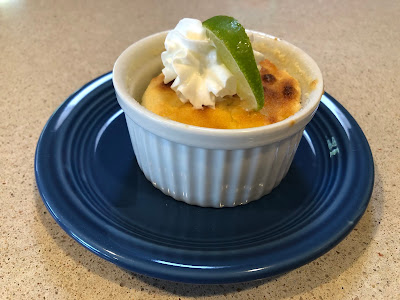
Garnished and ready to serve: An individual
lime pudding cake. (Photos: Kathy Morrison)
|
Everything seems to be ripening sooner this year. Pomegranates in mid-October, and now limes, heralding the beginning of citrus season.
My 6-foot Bearss seedless lime tree has been loaded with fruit this year. I realized this past week that the rind on several limes was lightening, turning more of a yellow-green. In other words, the fruit was ripening. (Yes, limes are typically picked before they are ripe.)
Quick, dig out recipes using limes! I have plenty of savory dishes, chicken and fish especially, but wanted to find a new baking recipe that would put the lime flavor center-stage.
The recipe here is my combination of several for individually baked pudding cakes.
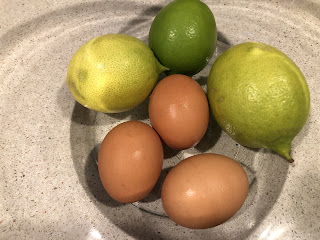
Limes and eggs rest in a glass bowl. The three limes
show varying degrees of ripeness, but were all
picked the same day.
|
Pudding cakes, which often are chocolate or lemon, use just a bit of flour and several separated eggs to achieve a treat that has moist cake on top of a custard base, which separates out while the cake bakes. The pan, or in this case the set of ramekins, sits in a pan of hot water, a technique with the French name "bain-marie."
This might seem a little fussy, but no more so than baking and frosting a batch of cupcakes. And the pudding cakes can be eaten warm, room temperature or chilled, which means they can be made far ahead of serving, if desired.
The ramekins also have the advantage of containing the pudding to the dish it's served in; scoops from one large cake might spread a bit, especially any leftovers.
Top with some whipped cream and a lime slice for a beautiful presentation.
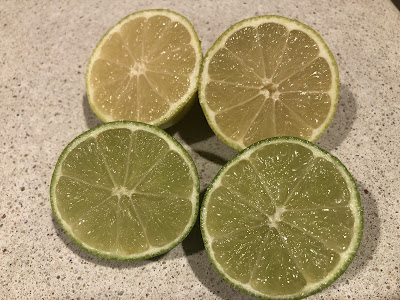
front; halves of a ripe one are in back. |
Lime pudding cakes
Serves 6
Ingredients:
Cooking oil spray
1/2 cup plus 2-1/2 tablespoons granulated sugar, divided
3 large eggs, room temperature, separated
1/8 teaspoon kosher salt
3 tablespoons unsalted butter, room temperature
1/4 cup unbleached all-purpose flour
1 cup lowfat milk
Zest from one large lime, plus more for garnish if desired
5 tablespoons fresh lime juice
Whipped cream, for garnish, optional
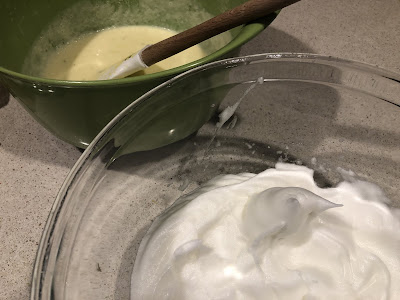
Egg whites whip up to peaks easily when they're room
temperature.
|
Instructions:
Place an oven rack in the middle of the oven. Turn on oven to heat to 350 degrees. Have 1 quart or more of hot water available, either in a kettle or heated in the microwave. It doesn't have to be boiling, but should be hot rather than warm, and in a container that's easy to pour from.
Spray 6 ramekins (6-ounce) or 1-cup wide-mouth Mason jars with oil spray. Use the 2-1/2 tablespoons sugar to coat the insides of the ramekins. Set them aside.
Place the egg whites in a clean, dry glass or metal bowl. Add the salt and beat the egg whites with an electric mixer, on low at first, then on medium-high, until the egg whites hold a peak when the beaters are lifted out. Set the bowl aside.
In a large bowl, beat together the butter and the 1/2 cup sugar until light, then add the egg yolks one at a time, mixing well after each. Stir in the flour, then add about 1/3 of the milk, blend it in, add another 1/3, blend and then add the rest. Finally, stir in the lime zest and the lime juice. The batter will be very liquidy.
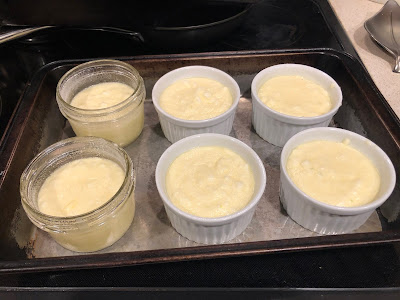
I had only 4 ramekins of the same size, so used small wide
Mason jars for the other two puddings. These are ready for the
hot water to be poured into the outer pan. |
Gently fold the egg whites into the lime mixture. Don't worry about getting every clump of egg white mixed in, but there shouldn't be large clumps.
Divide the batter evenly between the six prepared ramekins. Place the ramekins in a 9-by-13-inch roasting pan or other high-sided baking dish. They should fit comfortably, with space in between.
Two ways to fill the pan with water:
-- If you're strong enough to lift a heavy pan, place the roasting pan on the stovetop or counter and gently pour the hot water into the outer pan so the water comes halfway up the side of the ramekins. Carefully move the filled pan to the rack in the oven and center it on the rack.
-- OR, if you don't want to risk dropping the pan, instead open the oven, pull out the oven rack halfway, and place the roasting pan on it so that it's well-balanced. Then pour the hot water into the outer pan so that the water comes halfway up the sides of the ramekins.
Bake for 30-35 minutes. The tops of the puddings should be turning golden brown and puffy, and some may have cracks in them.
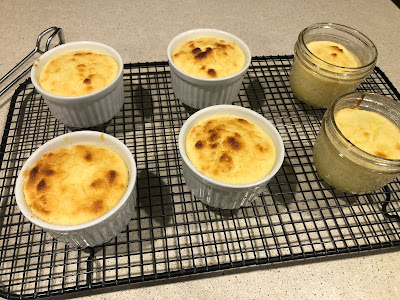
|
Carefully move the roasting pan to a cooling rack or heatproof surface to cool off for a few minutes. Use tongs or hot pads to remove the ramekins from the water; place the ramekins on a cooling rack for about 10 minutes before serving, or cool completely, then cover and refrigerate until ready to serve. The lime flavor intensifies and the layers become more pronounced after chilling.
Garnish with whipped cream and a lime slice or more lime zest if desired.
Comments
0 comments have been posted.Sacramento Digs Gardening to your inbox.
Sites We Like
Garden Checklist for week of July 21
Your garden needs you!
* Keep your vegetable garden watered, mulched and weeded. Water before 8 a.m. to reduce the chance of fungal infection and to conserve moisture.
* Feed vegetable plants bone meal, rock phosphate or other fertilizers high in phosphate to stimulate more blooms and fruiting. (But wait until daily high temperatures drop out of the 100s.)
* Don’t let tomatoes wilt or dry out completely. Give tomatoes a deep watering two to three times a week.
* Harvest vegetables promptly to encourage plants to produce more. Squash especially tends to grow rapidly in hot weather. Keep an eye on zucchini.
* Pinch back chrysanthemums for bushy plants and more flowers in September.
* Remove spent flowers from roses, daylilies and other bloomers as they finish flowering.
* Pinch off blooms from basil so the plant will grow more leaves.
* Cut back lavender after flowering to promote a second bloom.
* It's not too late to add a splash of color. Plant petunias, snapdragons, zinnias and marigolds.
* From seed, plant corn, pumpkins, radishes, winter squash and sunflowers.